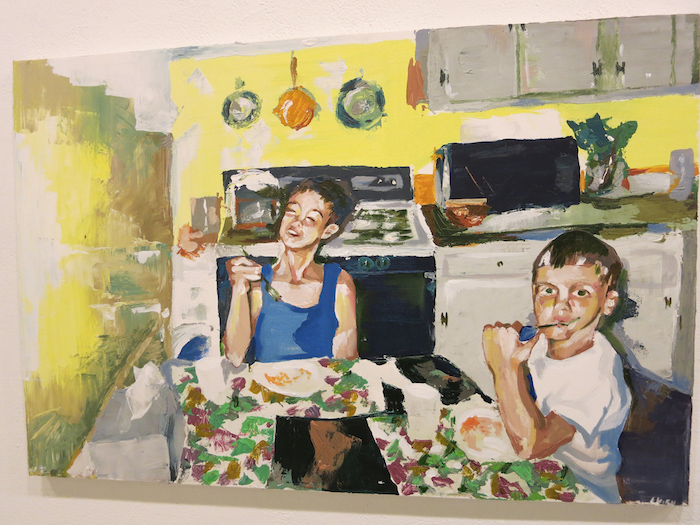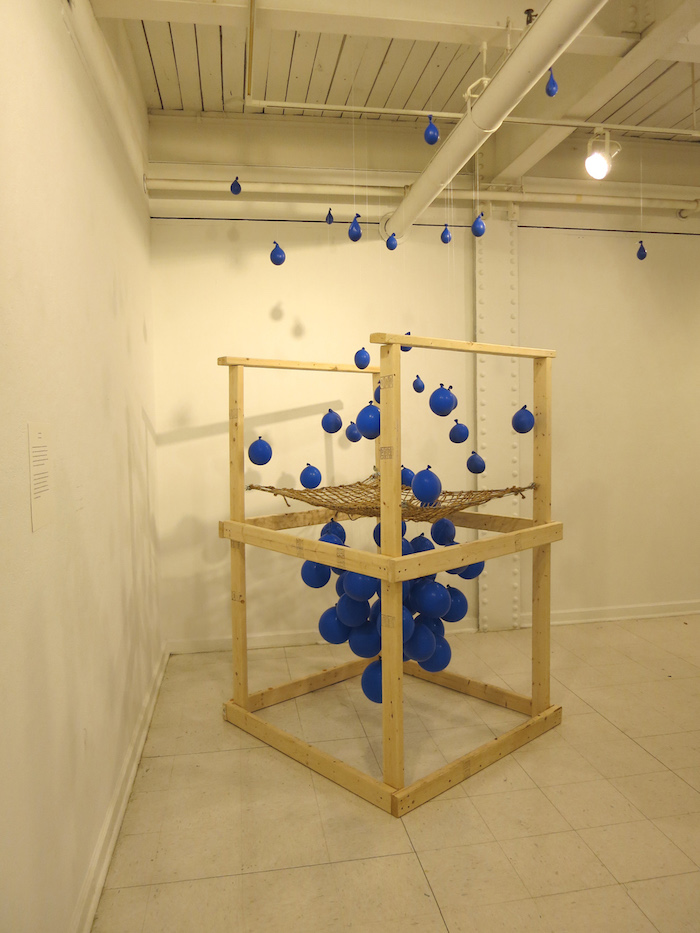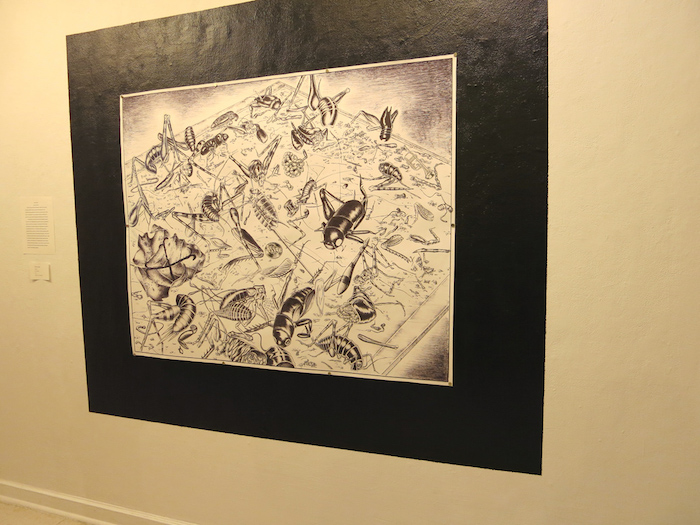The Second installment of thesis exhibitions for MICA’s Master’s of Art in Teaching occurred last weekend. This grouping of students and work felt cohesive in subject matter and interests, yet diverse in execution. Many of the works were inspired by personal connections to other people. Some positive, while others negative, but all dove into the arena of human relationships. There was also a theme of female empowerment dispersed throughout the exhibition.

“Giant Woman” by Melanie Ruston was as it sounds, a wall painting of a giant woman towering over viewers and stepping on illustrative trees. The two painted walls housing Ruston’s work were playful and strong, with a poem to reinforce the story of the giant woman. Ruston’s work was well executed and humorous at the same time.

On the opposite side of the room an aggressively drawn narrative scrawled the walls. Samatha Stewart, through words and pink figurative marks, created a personal and explicit story of experiences as told by the female. Viewers that stopped to read the wall text were instantly pulled into the work and many stayed with to finish the story, possibly with hopes of justice for the storyteller. From a distance the hand-painted text felt like a drawing with rows and rows of irregular, human lines.

Taryn Riley also presented work that depicted women. Painted on tablecloths and surrounded by fringe, the stereotypical material and color choices are meant to poke fun at gender roles. Riley’s figures are lushly painted in oil, questioning the adornment of women by pairing them with unexpected props. It is interesting to think of Riley, Stewart, and Ruston in the classroom and how they might approach gender stereotypes in a teaching context.

Most of the remaining works in the exhibition dealt in family and close relationships. Megan Liggett chose to explore the Scottish heritage within her family through a series of embroideries. The works were arranged in the shape of the country Scotland and also include a new crest, one that Liggett created to represent the future of her family, in addition to the past. The pieces are delicate and the material choices feel appropriate for someone exploring personal history.

India Maureen Cox also considered her past to be ripe with inspiration. She displayed a large paper sculpture, made of many small drawings on a green wall. Each small hexagonal piece of paper held a map, created from memory, of kitchens in which she grew up. The piece, titled Recipe Box, combined all of the graphite drawings, reminiscing with words and doodles and presented as if it were a quilt. All elements and presentation choices are working to reinforce the idea of home and memory, culminating in one sculptural form.

Love Notes was a collection of drawings and paintings by Lillian Kirk. Kirk, who was a GFA undergraduate major at MICA, depicted important people in her life using paint and graphite. Kirk chose to work from photographs that perfectly capture ‘slice of life’ adolescent moments. She turned them into lively oil paintings as well as intimate graphite drawings. Kirk notes that the size and material choices for each work coincides with the personality of the person being depicted.

Caitlin Finnegan displayed a similarly inspired body of work titled The Givers. This collection of small drawings also celebrated important individuals in her life that gave something to her over the years. Graphite and Conte marks on wood mimic the marks that those in the portraits have left on her life. The portraits are tiny, but feel important, and all exist on small oval, wooden plaques.

Britt Salem focuses on people, but from an outside point of view. Salem’s photographs are exclusive to Baltimore inhabitants and their respective neighborhoods. Salem counters beautiful portraits with the often-negative light in which our city is depicted. The individuals pictured are all shown on their porches or stoops, something as iconic to Baltimore as its crime. The photos are mounted and housed in a small room within the gallery. This allows the viewer to feel as if they are in a space with those in the work, something I think Salem would appreciate, as she has titled the series Neighbors.

A geometric structure stood as a home to a precarious net and a series of strung blue balloons. Jessica Walther spoke about wanting to create a space, possibly one that invited interaction or exploration. This work became a visual focal point in the room, as it had a whimsical and aesthetically pleasing presence. This piece was born from experimentation; Walther explained that many of her past works were not only not sculptural, but often contained the figure. Though her newest work still holds a relationship to the body, it beckons viewers to ponder how they exist in relationship to the piece.

The intimacy of the works I experienced for this exhibition continued with Sharon Kusiak. Kusiak presented a large-scale drawing hung on a large black painted frame. The work on paper was full of metaphors and visual stand-ins for a rocky personal past. The artist opened up about a history of substance abuse, which could have led her down an irreversible path. Jiminy Cricket is present in the drawing, acting as a morbid reference, not only to childhood but also our ultimate mortality. Kusiak has overcome, as many have, a personal struggle and has used creative processes to work through these experiences. Like the others in the show, she did not shy away from her own personal history, and emphasized the way it acts as a marker in forming relationships with others.
MICA’s MAT Thesis II Exhibition will be on view through March 1, 2015. More information is available at the MICA Grad Show 2015 Website.
Author Amy Boone-McCreesh is a Baltimore-based artist and professor.
Top Image: Megan Liggett detail






